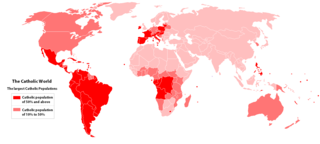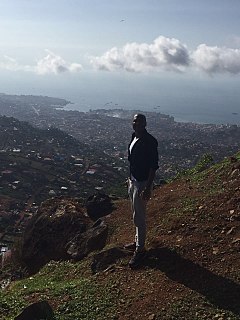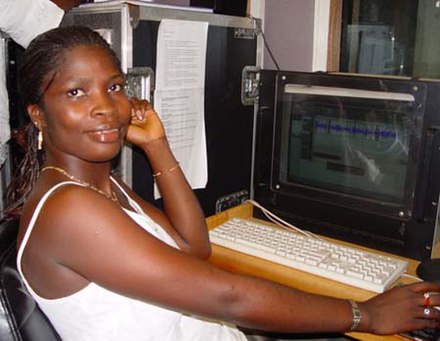
Sierra Leone, officially the Republic of Sierra Leone, informally Salone, is a country on the southwest coast of West Africa. It is bordered by Liberia to the southeast and Guinea to the northeast. Sierra Leone has a tropical climate, with a diverse environment ranging from savanna to rainforests, and a total area of 71,740 km2 (27,699 sq mi) and a population of 7,075,641 as of the 2015 census. The capital and largest city is Freetown. Sierra Leone is divided into five administrative regions, which are further subdivided into sixteen districts.
Telecommunications in Sierra Leone include radio, television, fixed and mobile telephones, and the Internet.

Kenema is the third largest city in Sierra Leone, and the largest city in the country's Eastern Province. It is the capital of Kenema District and a major economic center of the Eastern Province. At the 2015 national census Kenema had a population of 200,354.. Kenema is approximately 300 kilometres (185 mi) southeast of Freetown and about 60 kilometres (40 mi) south of Bo.

Makeni is the largest city in the Northern Province of Sierra Leone. The city is the capital of Bombali District, and is the economic center of the Northern Province. Makeni is the fifth largest city in Sierra Leone by population. The city of Makeni had a population of 80,840 in the 2004 census and a 2013 estimate of 112,428. Makeni lies approximately 137 kilometers east of Freetown. Makeni is home to the University of Makeni, the largest private university in Sierra Leone..

Koidu Town is the capital and largest city of the diamond-rich Kono District in the Eastern Province of Sierra Leone. The population of Koidu Town is 124,662 based on the 2015 Sierra Leone Census. Koidu Town is the fifth largest city in Sierra Leone by population, after Freetown, Kenema, Bo and Makeni. Koidu Town is a major urban, business, commercial and diamond trade center. Koidu Town lies approximately 270 miles east of Freetown, and about 54 miles north of Kenema.
The Archdiocese Freetown is a Roman Catholic diocese in Sierra Leone. It is centred on the city of Freetown, the capital and most populous city of the African country of Sierra Leone.

The Catholic Church in Sierra Leone is part of the worldwide Catholic Church, under the spiritual leadership of the Pope in Rome.
Sierra Leone FA Cup, commonly known as the FA Cup, is the national knockout cup competition in Sierra Leone. It was established in 1967. The competition is run by the Sierra Leone Football Association. Cup winners qualify for the CAF Confederation Cup.
Capital Radio is a Sierra Leone radio station based at the Mammy Yoko Business Park in Aberdeen, Freetown.

The following outline is provided as an overview of and topical guide to Sierra Leone:
Railway stations in Sierra Leone include:
The Sierra Leone Broadcasting Corporation (SLBC) is the national radio and television broadcaster in Sierra Leone. It is owned by the government of Sierra Leone and is a branch of the Sierra Leone Ministry of Information and Communications. It is theoretically regulated by the Independent Media Commission (IMC). The SLBC primarily broadcasts the national television and regional radio service from its headquarters in the New England neighborhood of Freetown. Regional stations provide FM radio services in Bo, Kenema, Kailahun, Makeni, Magburaka and Koidu.

There are 84 kilometres of railway in Sierra Leone, all of which is private and of a narrow gauge, 1,067 mm.
Union Trust Bank (UTB), whose full name is Union Trust Bank Limited, is a commercial bank in Sierra Leone. It is licensed as a "commercial bank" by the Bank of Sierra Leone, the central bank and national banking regulator.

Water supply in Sierra Leone is characterized by limited access to safe drinking water. Despite efforts by the government and numerous non-governmental organizations, access has not much improved since the end of the Sierra Leone Civil War in 2002, stagnating at about 50% and even declining in rural areas. In the capital Freetown, taps often run dry. It is hoped that a new dam in Orugu, for which China committed financing in 2009, will alleviate water scarcity.
The Inter-territorial Catholic Bishops' Conference of The Gambia and Sierra Leone (ITCABIC) is the episcopal conference of the Catholic Church in the Sierra Leone and The Gambia.
Rokel Commercial Bank (RCB) is a commercial bank in Sierra Leone. It is one of the commercial banks licensed by Bank of Sierra Leone, the national banking regulator.
Sierra Leone Commercial Bank (SLCB) is a commercial bank in Sierra Leone. It is one of the commercial banks licensed by the Bank of Sierra Leone, the country's central bank and national banking regulator.

The Leicester Peak transmitting station is a broadcast transmitting station and communications relay station located near Freetown, Sierra Leone. The site is owned by the Sierra Leone Broadcasting Corporation the country's state broadcaster. It is now the primary transmitting station providing broadcast services for the Western Area of Sierra Leone. Previously the SLBC operated a shortwave transmitting station in Waterloo and a shortwave/mediumwave station in Goderich.

The Sacred Heart Cathedral also simply called Cathedral of Freetown, is a religious building that is affiliated with the Catholic Church and is located in the Howe street of the town of Freetown, capital and most populous city of the African country of Sierra Leone.










